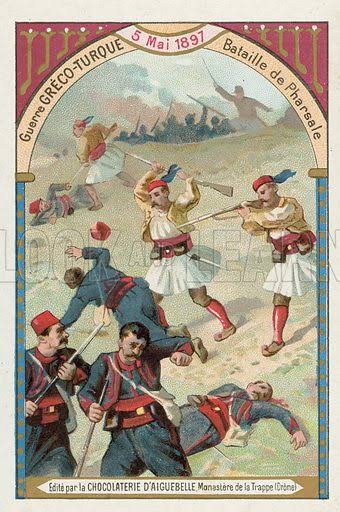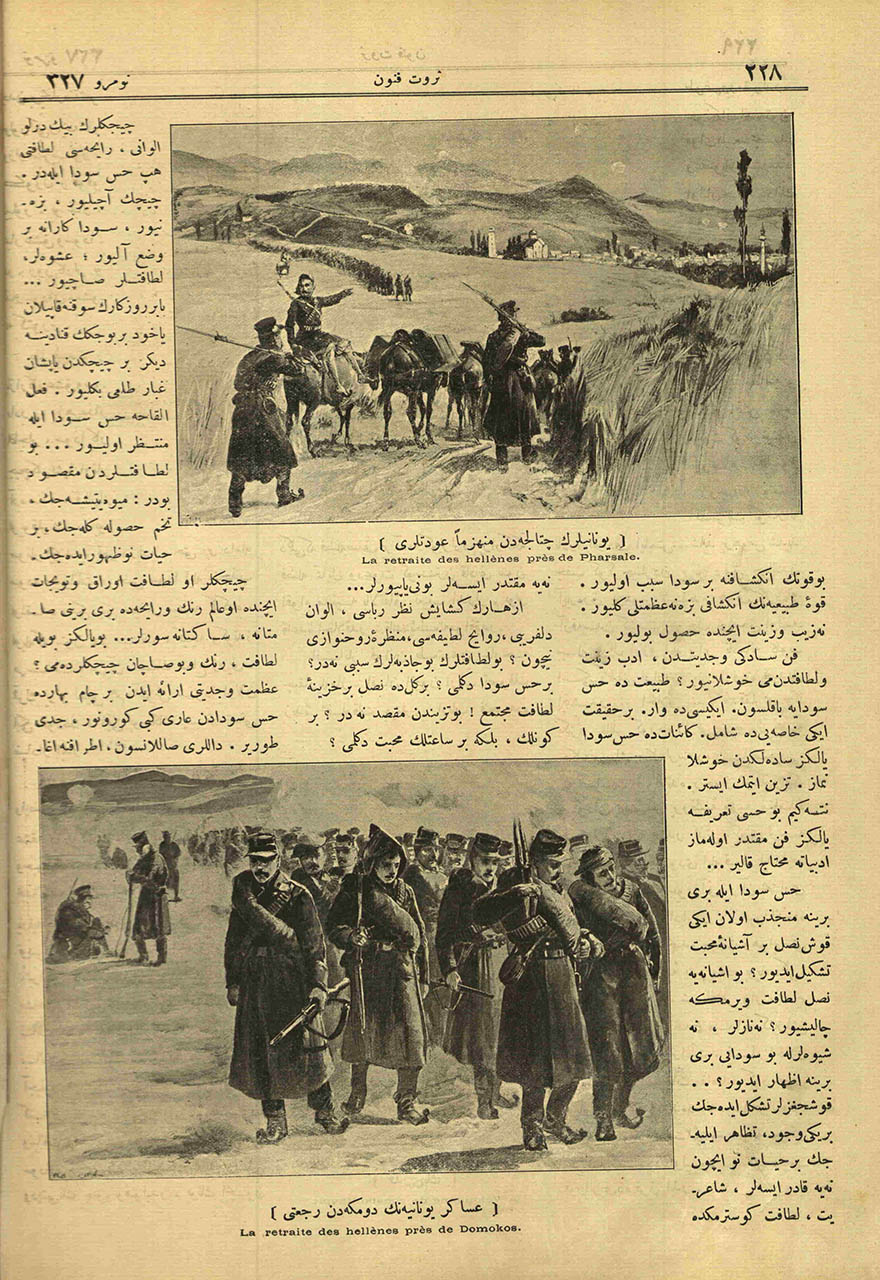as he describes his impatience with the Turks' council of
war prior to the Battle of Çatalca (Farsala).//
Map of the Battle of Çatalca (Farsala) that was
included in Ahmed İzzet Paşa's lecture. Çatalca
is at bottom-center. See current map below for
reference.
We then assigned a few young general staff officers to do this
reconnaissance. They were Capt. Rıza (who is now the Chief of Staff
of the 11th Army), Captain Sermed and Adjutant Major Mehmed Ali
(who is now the Chief of Staff of the 5th Army). Each of them went
with a 10-man detachment to determine the enemy's situation. The
drive and boldness they showed in the performance of duty was
astonishing. Two of them went through the flanks and emerged
between the enemy's vanguard and its main force, a very dangerous
place, where they met up with one another.
When it was learned that Prince Constantine had between 25,000 and
30,000 troops at Çatalca (Farsalos) and between 8,000 and 10,000 at
Velestino, the decision was made for us move on Çatalca, to where the
main Greek force had moved from Yenişehir. However, to do this we
first had to ensure that our own army did not disperse and assemble the
troops in a large mass.
So, as the result of disciplined insistence and communications, we
assembled three and a half divisions at Yenişehir and its vicinity and
left six battalions there to protect the Kostem Line and the bridges.
Upon receipt of approval from the Main HQS (Istanbul) we wrote an
order to the commander of the 1st Division, then at Tırhala (Trikala),
to takes his main force across the Ali Bey Bridge.
to takes his main force across the Ali Bey Bridge.
Farsala (red star). Tırhala (Trikala) is at left center.
Velestino (not shown) is west of Volos and south of Armeni.
On the matter of how to advance on Çatalca, there were three opinions.
Enver Paşa wanted to advance in three columns from Tırhala (Trikala),
Yenişehir and Velestino. This was dependent on the seizure of Velestino
but if the plan was thoroughly examined it would be serve as a good
example for external battle lines. But if the active enemy at Çatalc were
able to infiltrate these columns they could be defeated one by one.
Enver Paşa wanted to advance in three columns from Tırhala (Trikala),
Yenişehir and Velestino. This was dependent on the seizure of Velestino
but if the plan was thoroughly examined it would be serve as a good
example for external battle lines. But if the active enemy at Çatalc were
able to infiltrate these columns they could be defeated one by one.
A second idea was to fortify the division at Tırhala with another division
and attack from Tırhala and Yenişehir, thus covering the enemy's front
and left flank. Since this called for splitting up forces it was deemed
unsound. In addition, a movement from so far away would give the
enemy time to reconnoiter and prepare.
and attack from Tırhala and Yenişehir, thus covering the enemy's front
and left flank. Since this called for splitting up forces it was deemed
unsound. In addition, a movement from so far away would give the
enemy time to reconnoiter and prepare.
Our proposal was different. Neşet Paşa, Hamdi Paşa and Memduh Paşa's
divisions would advance along parallel paths and occupy the enemy
front with an attack, after which they would form the main force together.
Hayri Paşa's division and the cavalry division would completely
surround the Greeks' left flank, cutting off the line-of-retreat of Prince
Constantine's army to Dömeke.

This depiction of the Battle of Farsala shows the
Greeks attacking and theTurks on their heels, part
of the never-ending propaganda war - see the
Turks' counter-propaganda below.
front with an attack, after which they would form the main force together.
Hayri Paşa's division and the cavalry division would completely
surround the Greeks' left flank, cutting off the line-of-retreat of Prince
Constantine's army to Dömeke.
This depiction of the Battle of Farsala shows the
Greeks attacking and theTurks on their heels, part
of the never-ending propaganda war - see the
Turks' counter-propaganda below.
So, the army order was written with this goal. Before the order was
signed, though, there was a council of war convened. As the various
paragraphs were being read, everyone had an objection. Finally,
my patience ran out and, leaving the maps there, I departed in a huff.
Crying all the way, I went home. Most councils of war come up with
bad decisions and results but this council of war ended before even a
bad decision was approved. Essentially, two opposing ideas were
holding sway at the HQS. The older officers were in favor of the
troops following one another, with the units moved in parts. We,
however, favored moving the entire army en masse for a decisive
clash with the enemy.
In an effort to accommodate both of these positions, it was proposed
that the divisions would move out at two-hour intervals along the
roads we had designated but we did not accept this compromise.
Ultimately, our plan was accepted almost exactly as we had first
presented it. We had to make a slight concession, though. In our plan,
Haydar Paşa's brigade would 'follow' Neşat Paşa's division. We agreed
to drop the word 'follow' and changed it to 'stay in reserve at a fixed
point'. In this way, we succeeded in having our plan accepted.
that the divisions would move out at two-hour intervals along the
roads we had designated but we did not accept this compromise.
Ultimately, our plan was accepted almost exactly as we had first
presented it. We had to make a slight concession, though. In our plan,
Haydar Paşa's brigade would 'follow' Neşat Paşa's division. We agreed
to drop the word 'follow' and changed it to 'stay in reserve at a fixed
point'. In this way, we succeeded in having our plan accepted.
For these reasons, there was a day's delay in mobilization. This,
however, proved to be beneficial because the division at Tırhala did
not want to leave there. With the one-day delay in the main force's
movement, the Tırhala division moved, as well, creating the combined
main force.

This page from the Servet-ı Fünûn newspaper,
Istanbul, describes the battles of Çatalca (top) and
the subsequent battle at Dömeke (bottom)
with pictures of demoralized Greek soldiers.
//END of PART VI//
however, proved to be beneficial because the division at Tırhala did
not want to leave there. With the one-day delay in the main force's
movement, the Tırhala division moved, as well, creating the combined
main force.

This page from the Servet-ı Fünûn newspaper,
Istanbul, describes the battles of Çatalca (top) and
the subsequent battle at Dömeke (bottom)
with pictures of demoralized Greek soldiers.
//END of PART VI//


Hiç yorum yok:
Yorum Gönder